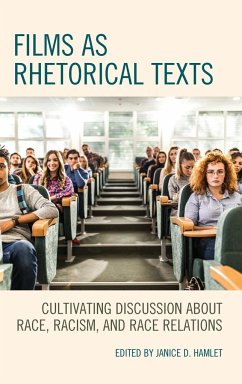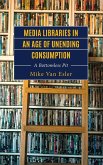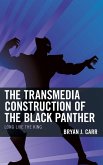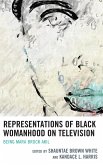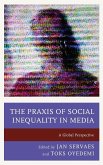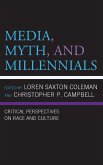Films as Rhetorical Texts
Cultivating Discussion about Race, Racism, and Race Relations
Herausgeber: Hamlet, Janice D.
Films as Rhetorical Texts
Cultivating Discussion about Race, Racism, and Race Relations
Herausgeber: Hamlet, Janice D.
- Gebundenes Buch
- Merkliste
- Auf die Merkliste
- Bewerten Bewerten
- Teilen
- Produkt teilen
- Produkterinnerung
- Produkterinnerung
This book analyzes films as rhetorical texts capable of having an influential impact on viewers' interactions with others. Contributors use culture-centered films, especially those focusing on race, ethnicity, and gender, to generate open discussions about race, racism, and race relations in the United States.
Andere Kunden interessierten sich auch für
![Media Libraries in an Age of Unending Consumption Media Libraries in an Age of Unending Consumption]() Mike van EslerMedia Libraries in an Age of Unending Consumption99,99 €
Mike van EslerMedia Libraries in an Age of Unending Consumption99,99 €![Race, Representation, and Satire Race, Representation, and Satire]() Race, Representation, and Satire114,99 €
Race, Representation, and Satire114,99 €![The Transmedia Construction of the Black Panther The Transmedia Construction of the Black Panther]() Bryan J. CarrThe Transmedia Construction of the Black Panther124,99 €
Bryan J. CarrThe Transmedia Construction of the Black Panther124,99 €![Representations of Black Womanhood on Television Representations of Black Womanhood on Television]() Representations of Black Womanhood on Television110,99 €
Representations of Black Womanhood on Television110,99 €![Existential Science Fiction Existential Science Fiction]() Ryan LizardiExistential Science Fiction99,99 €
Ryan LizardiExistential Science Fiction99,99 €![The Praxis of Social Inequality in Media The Praxis of Social Inequality in Media]() The Praxis of Social Inequality in Media121,99 €
The Praxis of Social Inequality in Media121,99 €![Media, Myth, and Millennials Media, Myth, and Millennials]() Media, Myth, and Millennials121,99 €
Media, Myth, and Millennials121,99 €-
-
-
This book analyzes films as rhetorical texts capable of having an influential impact on viewers' interactions with others. Contributors use culture-centered films, especially those focusing on race, ethnicity, and gender, to generate open discussions about race, racism, and race relations in the United States.
Produktdetails
- Produktdetails
- Verlag: Lexington Books
- Seitenzahl: 242
- Erscheinungstermin: 13. November 2019
- Englisch
- Abmessung: 235mm x 157mm x 19mm
- Gewicht: 549g
- ISBN-13: 9781793602718
- ISBN-10: 1793602719
- Artikelnr.: 57585168
- Herstellerkennzeichnung
- Libri GmbH
- Europaallee 1
- 36244 Bad Hersfeld
- gpsr@libri.de
- Verlag: Lexington Books
- Seitenzahl: 242
- Erscheinungstermin: 13. November 2019
- Englisch
- Abmessung: 235mm x 157mm x 19mm
- Gewicht: 549g
- ISBN-13: 9781793602718
- ISBN-10: 1793602719
- Artikelnr.: 57585168
- Herstellerkennzeichnung
- Libri GmbH
- Europaallee 1
- 36244 Bad Hersfeld
- gpsr@libri.de
Janice D. Hamlet is associate professor in the Department of Communication and director of diversity, equity, and inclusion at Northern Illinois University.
Introduction: There's an Elephant in the Room and it's Not Leaving:
Engaging Discussions about Race, Racism and Race Relations Chapter One: The
Story of Right Hand, Left Hand: The Rhetoric of Racial Angst in Spike Lee's
Do the Right Thing Chapter Two: The Spice of Life: Discussing Diversity and
Disparity in Mississippi Masala Chapter Three: The Ties that (UN) bind:
Whiteness and the Racialization of Jewish Bodies in the film School Ties
Chapter Four: Smoke Signals: Opening the Conversation to Untold Stories
from the First Americans Chapter Five: "White-Side, Strong Side": A
Critical Examination of Race and Leadership in Remember the Titans Chapter
Six: The Difficult Dialog of Critical Race Theory through the Lens of Crash
Chapter Seven: No Filter: Counter-Storytelling and The Help Chapter Eight:
Fruitvale Station: A Humanistic and Vulnerable Glimpse into Black
Masculinities Chapter Nine: Zootopia: Using a Utopia to Facilitate
Conversations about a Dystopia in Society Chapter Ten: Gook and the
Conversation Within Chapter Eleven: Theft and White Supremacy: Cultural
Implications of Mudbound Chapter Twelve: De-essentializing Race through
Dialectic Analysis of The Big Sick Chapter Thirteen: Wakanda's Prodigal
Son: A Critical Race Theory Analysis of the Relationship between Africans
and African Americans as Represented in Black Panther
Engaging Discussions about Race, Racism and Race Relations Chapter One: The
Story of Right Hand, Left Hand: The Rhetoric of Racial Angst in Spike Lee's
Do the Right Thing Chapter Two: The Spice of Life: Discussing Diversity and
Disparity in Mississippi Masala Chapter Three: The Ties that (UN) bind:
Whiteness and the Racialization of Jewish Bodies in the film School Ties
Chapter Four: Smoke Signals: Opening the Conversation to Untold Stories
from the First Americans Chapter Five: "White-Side, Strong Side": A
Critical Examination of Race and Leadership in Remember the Titans Chapter
Six: The Difficult Dialog of Critical Race Theory through the Lens of Crash
Chapter Seven: No Filter: Counter-Storytelling and The Help Chapter Eight:
Fruitvale Station: A Humanistic and Vulnerable Glimpse into Black
Masculinities Chapter Nine: Zootopia: Using a Utopia to Facilitate
Conversations about a Dystopia in Society Chapter Ten: Gook and the
Conversation Within Chapter Eleven: Theft and White Supremacy: Cultural
Implications of Mudbound Chapter Twelve: De-essentializing Race through
Dialectic Analysis of The Big Sick Chapter Thirteen: Wakanda's Prodigal
Son: A Critical Race Theory Analysis of the Relationship between Africans
and African Americans as Represented in Black Panther
Introduction: There's an Elephant in the Room and it's Not Leaving:
Engaging Discussions about Race, Racism and Race Relations Chapter One: The
Story of Right Hand, Left Hand: The Rhetoric of Racial Angst in Spike Lee's
Do the Right Thing Chapter Two: The Spice of Life: Discussing Diversity and
Disparity in Mississippi Masala Chapter Three: The Ties that (UN) bind:
Whiteness and the Racialization of Jewish Bodies in the film School Ties
Chapter Four: Smoke Signals: Opening the Conversation to Untold Stories
from the First Americans Chapter Five: "White-Side, Strong Side": A
Critical Examination of Race and Leadership in Remember the Titans Chapter
Six: The Difficult Dialog of Critical Race Theory through the Lens of Crash
Chapter Seven: No Filter: Counter-Storytelling and The Help Chapter Eight:
Fruitvale Station: A Humanistic and Vulnerable Glimpse into Black
Masculinities Chapter Nine: Zootopia: Using a Utopia to Facilitate
Conversations about a Dystopia in Society Chapter Ten: Gook and the
Conversation Within Chapter Eleven: Theft and White Supremacy: Cultural
Implications of Mudbound Chapter Twelve: De-essentializing Race through
Dialectic Analysis of The Big Sick Chapter Thirteen: Wakanda's Prodigal
Son: A Critical Race Theory Analysis of the Relationship between Africans
and African Americans as Represented in Black Panther
Engaging Discussions about Race, Racism and Race Relations Chapter One: The
Story of Right Hand, Left Hand: The Rhetoric of Racial Angst in Spike Lee's
Do the Right Thing Chapter Two: The Spice of Life: Discussing Diversity and
Disparity in Mississippi Masala Chapter Three: The Ties that (UN) bind:
Whiteness and the Racialization of Jewish Bodies in the film School Ties
Chapter Four: Smoke Signals: Opening the Conversation to Untold Stories
from the First Americans Chapter Five: "White-Side, Strong Side": A
Critical Examination of Race and Leadership in Remember the Titans Chapter
Six: The Difficult Dialog of Critical Race Theory through the Lens of Crash
Chapter Seven: No Filter: Counter-Storytelling and The Help Chapter Eight:
Fruitvale Station: A Humanistic and Vulnerable Glimpse into Black
Masculinities Chapter Nine: Zootopia: Using a Utopia to Facilitate
Conversations about a Dystopia in Society Chapter Ten: Gook and the
Conversation Within Chapter Eleven: Theft and White Supremacy: Cultural
Implications of Mudbound Chapter Twelve: De-essentializing Race through
Dialectic Analysis of The Big Sick Chapter Thirteen: Wakanda's Prodigal
Son: A Critical Race Theory Analysis of the Relationship between Africans
and African Americans as Represented in Black Panther

